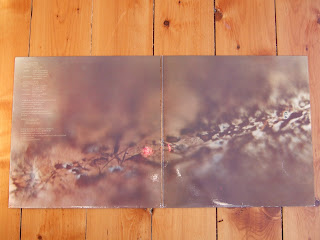Despite having just performed what still remains one of my favourite gigs, they were a quiet bunch afterwards, close knit in the corner and keeping to themselves.
Many of best bands have a cult-like quality about them and the way they circled around David Roback brought that to mind.
I was there with the support band, who were old friends, and in contrast to the main act they were in a lively mood after playing in front of one of their biggest ever crowds.
Drummer Keith Mitchell was the only one who was happy to mix, explaining why he'd played such a dark venue in sunglasses by telling us that when he'd first auditioned for Green On Red, Dan Stuart had told him he could have the gig as long as he played in the shades he'd first turned up in - when he auditioned for Opal, Roback also insisted on the sunglasses. 'Looks like I'm stuck with f**kin' things,' he shrugged.
Another former Opal member, Suki Ewers, was also back in the band that night, playing keyboards and guitar despite not appearing on the album.
That chemistry between Roback, Ewers and Mitchell dated back in 1984 when they had first played in Opal together, the now largely forgotten precursor to Mazzy Star, who laid down much of the blueprint for what was to come in two curiously different albums.
Both are long out of print, including on CD, which is a great shame. Like much of the Paisley Underground stuff of that era, some reappraisal is surely due.
Happy Nightmare Baby was their only album while together, with the Early Recordings compilation following in 1989, two years after they'd split.
The big difference between Opal and Mazzy Star is Kendra Smith, the singer who Roback stole from The Dream Syndicate and wooed into his bed and new band after himself leaving Rain Parade following their debut album in 1983.
Early Recordings mainly comprises the first three EPs released by the new band, the first under the name Clay Allison.
Their early efforts were dreamy and laidback, Roback mainly playing acoustic guitar with Ewers' keyboards given plenty of prominence and Smith centre-stage.
The VU's sweeter moments, including Sunday Morning, Femme Fatale and Jesus, come to mind, with blues and 1960s folk-rock influences mixed in, rounding out a plaintive, slightly naive sound.
My Only Friend (which those of a cynical bent could read as a heroin love song in the Lou Reed mould), Grains Of Sand and Northern Line are all gentle, lazy, subtly hypnotic and pretty much perfect.
Ewers provides two sweet and simple songs, Strange Delight and Brigit On Sunday, the latter of which she also sings.
Roback has a stab at lead vocals as well on Lullaby, a slightly gothic children's song. The final track, All Souls, is almost hymn-like.
Letting these hazy, entrancing songs wash over you is wonderful when you're sat on your sofa but you could imagine how they got drowned out by audience chatter when they played live.
You could certainly see how they came to the conclusion that turning up the guitars was the way to get noticed - which is exactly what they did on their long delayed debut album, Happy Nightmare Baby.
HNB arrived four years after the band had formed and seems determined to make its mark, opening up with Rocket Machine, which borrows heavily from T.Rex with its psychedelic swagger and almost exaggerated guitar riff.
The folk and blues influences have been traded in for The Doors, Television, Quicksilver Messenger Service and Buffalo Springfield.
Roback plays the guitar god like never before or since, overcooking it at times but anyone who enjoys the slowly unfurling fronds of psychedelic guitar he's trademarked will find much to enjoy here, particularly in Soul Giver and Siamese Trap.
Ewers is still very much central, also beefing up her sound and bringing to mind Ray Manzarek's organ style in the ways she plays off Roback.
The one song HNB shares with Early Recordings is She's A Diamond, which hightlights the new direction perfectly - a bluesy acoustic lament to start with, it's now a chugging slice of swaggering riffage.
Magick Power even comes over all mystical with its lyrics about 'electric children over the moon'.
Roback did a slightly dodgy job of producing, with everything sounding rather murky and the vocals too weak, which didn't seem to help sales, along with the general confusion caused among the band's small fan base by the change in direction.
Smith quit halfway through the following tour, while they were supporting the Jesus & Mary Chain.
She was rapidly replaced by a teenage Hope Sandoval, who also ended up replacing Smith in Roback's bed. This version of Opal didn't last long before they transformed into Mazzy Star and therein lies a while other story.
Years later, Sandoval would break up with Roback and end up with William Reid of the J&MC. There's a weird symmetry in there somewhere...
Smith later emerged with a mini album and a solitary full LP, both of which are patchy but interesting. The 4AD website claims she was last heard of living in a cabin without electricity in rural California. This cover of Joy Division's Heart and Soul from 1995 is the most recent sighting.








